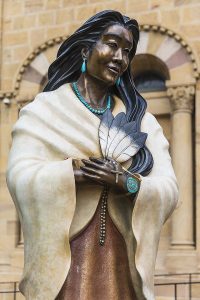Please subscribe to our emails for up-to-the-minute updates.
Details on weekday services and events can be found here.
Wednesday, 17 April, 2024
S. KATERI TEKAKWITHA, VIRGIN
6:15 p.m. Solemn High Mass
(Both in-person and online)
Celebrant: The Father Vicar
Preacher: Archbishop Chris Harper,
National Indigenous Anglican Archbishop & Presiding Elder of Sacred Circle
Sung by:
Sopranos: Sinead White, Margaret Cormier
Altos: Veronika Anissimova, Rebecca Claborn
Tenors: Jamie Tuttle, Robert Busiakiewicz
Basses: Bryan Martin, Sean Nix
Choir Direction by: Robert Busiakiewicz
Cantrix: Katherine Hill
Service Music:
Prelude: Sarabande from Overture after the French manner, BWV 831 – J.S. Bach (1685-1750)
Mass Setting: Missa Super Dorium – Jacobus Gallus (1580)
Opening Anthem: Ambe – Andrew Balfour (1967- )
Offertory Motet: Audi Filia – Clemens Non Papa (c.1510-1556)
Communion Motet: Sic Deus Dilexit Mundum – Ludwig Senfl (c.1490-1543)
Live-stream Link | Download Leaflet
About S. Kateri

Canonized by Pope Benedict XVI in 2012, devotion to S. Kateri Tekakwitha, known as the Lily of the Mohawks, stretches back several centuries. Recognized as Canada’s protectress, Kateri, who was baptized ‘Catherine’ by a French Jesuit priest at Easter, 1676, endured disease, violence, and rejection, dying a consecrated virgin at Kahnawake, Quebec, only twenty-four years of age. Devotion to ‘the Geneviève of Canada,’ as one contemporary prelate described her, spread rapidly across North America, with pilgrimages, churches, statues, and shrines, dedicated to her fame. The more recent localization of S. Kateri’s cult in the United States, separating her from both the Canadian and Mohawk contexts, is tempered by a recognition of the gift of S. Kateri to all Indigenous people.
About the Music
One of the privileges of being involved in Anglican music-making is that it embraces repertoire from diverse traditions and spans many centuries. Victorian hymns, Renaissance polyphony, contemporary anthems, and spontaneous improvisation: all within a single liturgy. The first anthem is by the Winnipeg-based musician, Andrew Balfour, a composer of Cree descent, who was gifted an original Ojibway song ‘Ambe’ by the traditional drummer and singer, Cory Campbell in 2017. Balfour taught this piece to a number in the choir today during last year’s National Day for Truth and Reconciliation.
The two composing Jacks, Jacobus Gallus (Gallus meaning Rooster) and Jacobus Clemens Non Papa (i.e. Mr. Not-the-Pope), were both alive in the middle of the 16th Century working in central Europe. The latter’s Audi Filia is a setting of Psalm 45 which elaborates on the appointed Tract and Gradual for this feast day. It is filled with sumptuous harmony, perhaps relishing in depicting a sonic version of ‘speciem tuam’ – ‘your beauty’. The piece ends with a vibrant ‘Alleluia’, a real masterclass in imitative counterpoint and dissonant false-relations. Gallus’s Mass, ‘Super Dorium’, is so named because it is based on the Dorian mode. This mode is a type of musical scale with certain notes sharpened and flattened to give it a distinct character, which is different from our ordinary ‘do-re-mi’ scale. The cascading scales in the Kyrie and Sanctus give the piece a florid quality, while the Agnus Dei is much more subdued. The opening of the Agnus Dei can sound quite modern to our contemporary ears, because it is filled with an unusually high number of dissonant ‘passing notes’.
Ludwig Senfl (Senfl meaning Mustard), was working in the generation before Gallus and Clemens. A native Switzer, he would go on to work for Emperor Maximillian I in Augsburg before taking up roles in Vienna and Munich. The Institute of Musicology in the University of Vienna has in the past decade produced a new complete edition of Senfl’s works, from which today’s Communion motet has been extracted. His setting of ‘God So Loved The World’ from the Gospel of John is written for six voices, and is the kind of music which is enjoying a revival in this highly-connected digital age. It is based on the plainsong antiphon for the same text, and was found in a part-book printed 490 years ago in 1534. RB
